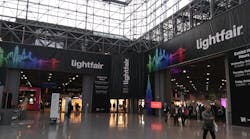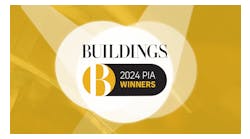The lighting industry is moving at warp speed to respond to the needs of building owners and managers, from flexible new design options to customizable color temperatures. LightFair International 2021, the top lighting event of the year, showcased exciting new technologies and strategies for lighting commercial spaces. BUILDINGS discovered these four top lighting trends at LightFair.
1. Color Temperature and Wattage Selectability
Today’s architects, designers and building owners have plenty of options when it comes to energy efficiency and high lumen output. But what can you do when your new lighting is just too bright? Manufacturer and supplier EarthTronics offers products that allow you to change your color temperature and wattage on-site, making it easy to adjust if one space needs a little less light or a different look.
“The end user may have thought they had a preference for 5000K because they’ve been taught that it gives good visual clarity, but they might find that in their environment, they don’t like the way their carpet or walls look and they need a change in their color temperature to balance it,” explained Kevin Youngquist, executive vice president of EarthTronics. “Now they have the opportunity to do that.”
2. Breaking Free from Ceiling Grids
LightFair is the place to find the latest and greatest options for lighting design. PureEdge Lighting, a Chicago-based manufacturer of low-voltage architectural lighting systems, introduced new lighting options that allow designers to depart from the typical 2x2 and 2x4 options typically seen in grid ceilings.
The FreeForm T-Bar Ceiling is made of modular straight runs that allow designers to create geometric shapes along the ceiling. Its channels clip to the grid. Lazer Line is an RGB+W suspended LED tape that can stretch up to 60 feet from wall to wall; its turnbuckles can be mounted wall to wall, ceiling to wall or ceiling to floor.
[Related: Facts and Fiction of Tunable Lighting]
“It can do uplight and downlight at the same time,” Heather Lowrey, marketing manager for PureEdge Lighting, said of the RGB+W Lazer Line. “You could do downlight with tunable white and uplight with RGB, so you could do a blue, purple or red ceiling and get creative with it. It’s very flexible.”
3. User-Friendly Lighting Controls
The right lighting controls can save energy and money by allowing facilities staffs and individual users the ability to customize light levels to the activities happening in a space. However, the wrong lighting control—particularly one that’s hard to use or isn’t commissioned right—is a waste of money if it continuously malfunctions or is being ignored.
Toggled, a subsidiary of Altair, introduced its area lighting controller at LightFair. The ultra-user-friendly control suite can control a single lamp up to a floor, building, campus or portfolio. Different user groups can see different devices on the network, said Dan Hollenkamp, chief operating officer. For example, a building operator can see and control all of the lighting and devices for all of the tenants in their portfolio, while a tenant could control the devices in their own space and an individual user could control whichever fixtures are in their own office.
4. Human-Centric Lighting Strategies
Human-centric lighting—lighting that impacts human biological performance—isn’t a new concept, but it’s beginning to make inroads in the lighting market, according to James Tu, CEO of Energy Focus.
[Related: What You Need to Know About Human-Centric Lighting]
Circadian lighting, or lighting technologies that support people’s natural circadian rhythms, is “the next frontier of lighting” and is one human-centric option that can be applied at home, work or school, Tu said. In a nutshell, circadian lighting mirrors the color temperature you might find outside, delivering cooler lighting during the day when people need to focus and warmer lighting in the evening when they can wind down from the workday.
Not many buildings have adopted circadian lighting, Tu said, but they should—not only can it increase productivity, but it also supports comfort and sleep quality, which impact building occupants’ long-term health. Energy Focus’ circadian lighting solution, the EnFocus Suncycle Human-Centric Lighting Platform, features a 10-stage journey from 2700K to 6500K throughout the day, changing gradually according to the natural cycle of the sun. It utilizes the existing power line, so building owners only need to replace the switch and lamps to install circadian lighting.
Read next: Light Paints the Space at Ketra’s New Austin Headquarters


